Missing the game or a vital weather update is a big problem with a pint-size solution. These pocket radios will keep you in touch with essential broadcasts, information, and entertainment wherever you may be.
BobVila.com and its partners may earn a commission if you purchase a product through one of our links.
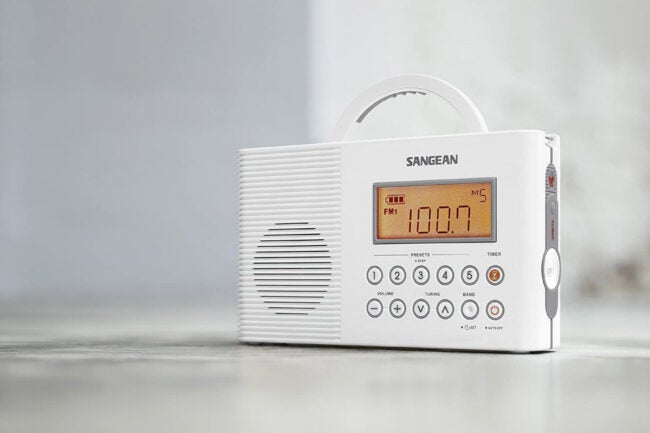
Photo: amazon.com
In a world ruled by streaming services and customizable playlists, a portable pocket radio may seem a bit old-fashioned. While it’s true that there are more modern and high-tech options, owning the best pocket radio still has its benefits.
Whether you’re on a camping trip or just trying to save your phone’s data or battery, having a pocket radio on-hand is a smart idea. You can stay up-to-date on important news and weather reports, or just pass the time with a favorite music station.
Pocket radios are small, lightweight, and easy to store. You can throw one in a backpack, a glovebox, or, as the name suggests, a pocket. This guide will explain exactly what you need to know about choosing the best pocket radio.
- BEST OVERALL: Sangean DT-160 AM/FM Stereo Pocket Radio
- BEST BANG FOR THE BUCK: DreamSky Pocket Radio
- BEST SHORTWAVE: Kaito KA321 Pocket-Size 10-Band Shortwave Radio
- BEST LONGWAVE: DreamSky AM FM Portable Radio
- BEST BLUETOOTH: PRUNUS J-288 AM/FM Hands-Free Bluetooth Radio
- BEST WATERPROOF: Sangean H201 AM/FM/Weather Alert Waterproof Radio
- BEST FOR WEATHER UPDATES: Vondior NOAA Weather Radio
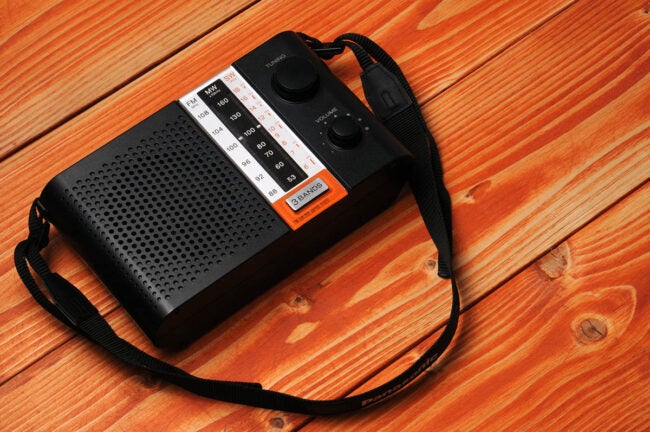
Photo: depositphotos.com
What to Consider When Choosing the Best Pocket Radio
Pocket radios are a bit of old-school technology, having been around for nearly 70 years. While they haven’t entirely gone the way of the dodo bird, you might’ve forgotten—or have never known—what it’s like to nail a station perfectly with your tuner dial for your favorite Friday night programming. Here are some things worth considering when choosing the best pocket radio.
Frequency Bands
Everyone loves choices, and the best pocket radios offer lots of options. You’ll be able to swap between AM and FM frequencies.
- While FM radio stations have the most music, they also have the shortest frequency ranges. You’ll have to be closer to the broadcasting tower to receive these transmissions.
- AM radio is a haven for talk shows, sportscasts, and weather reports, and the signal travels a much greater distance than FM because AM frequencies produce longer wavelengths that bounce off a layer of the atmosphere known as the ionosphere. AM radio is perfect for broadcasting life-saving information such as weather reports and important news updates.
Size and Weight
Pocket radios need to be light for convenience when toting around. If you’re backpacking, carrying a heavy radio powered by D batteries can really hamper your progress.
Choose a pocket radio that won’t tip the scales: You can find options that weigh less than half a pound. If the device has a built-in rechargeable battery, the weight savings can be significant, though you may have to charge it more often than you’d have to change replaceable batteries.
You don’t want a bulky radio, either. Choose a slim, compact version that fits easily into a jacket or pants pocket while still feeling comfortable to carry around.
Power Source
Portability is key when it comes to pocket radios, so you’ll find most of these radios use batteries. Rechargeable, built-in batteries are the most convenient for general use, as you can recharge your radio when it dies. However, this can be a real problem if you’re backpacking or camping in a remote location without a handy power supply.
If you’re looking for a radio to take on these types of adventures, consider checking into pocket radios with replaceable batteries. You can carry a few spare AA or AAA batteries with you in your pack.
If you like the idea of a rechargeable, built-in battery but find yourself “off the grid” quite a bit, try supplementing your portable radio with a solar charger or battery bank (both available on Amazon). Plenty of affordable options are available.
Station Presets
If you remember the annoyance of trying to tune your favorite radio station to a static-free frequency, you’ll appreciate a pocket radio that comes with programmable presets. They’re one of the better advancements for this old-school technology.
Many of the best pocket radios come with multiple presets, as many as 25 or more. They’re easy to set, and you can quickly toggle through a list of your favorite stations. While not as convenient as pressing “Play” on your perfectly curated playlist, it is a quicker way to get to listen to some of your preferred tunes without rolling the dial back and forth.
Headphone Jack
Built-in speakers are great, but for the maximum in portability and convenience, your pocket radio needs a headphone jack. Not everyone in the doctor’s office waiting room wants to listen to the sounds of smooth jazz or a politically charged talk show host, so be kind and keep your radio waves to yourself.
Most of today’s headphones use 3.5-millimeter headphone jacks, and this is probably the only size jack you’ll need on your portable radio. This makes your radio compatible with earbuds or most over-the-head headphones, so you can enjoy your tunes on the go without disturbing everyone around you—especially on a peaceful camping trip.
Belt Clip
Even if you have the smallest portable radio on the market, you may not always have a pocket. When you’re working out or carrying a lot of other essential gear in your pockets, you might benefit from a belt clip to keep your pocket radio onboard.
The best pocket radios have sturdy clips, some of which are removable, allowing you to slide your radio onto your belt, your waistband, or even your shirt pocket. These clips hold your radio securely in place over bumpy hikes or bike rides, so you don’t have to worry about losing it or experiencing the discomfort of your radio bumping around in your pocket.
Bluetooth/Wireless Connectivity
If you prefer to go completely wireless and use your Bluetooth headphones, you’re in luck. Some pocket radios feature Bluetooth connectivity, allowing you to go truly hands-free. Simply connect your headphones or Bluetooth-enabled speakers to your pocket radio, and you can enjoy your music completely unencumbered.
You can also use some pocket radios as portable Bluetooth speakers, which allow you to connect to your phone or other device and stream your favorite music without tolerating commercials.
These Bluetooth-enabled radios do cost a little more than a basic version, but what you’ll get in return for some extra money is freedom—and you won’t have to worry about headphone cords tangling up in the bottom of your backpack.
Our Top Picks
The following list of recommendations for the best pocket radios take all of the features and tips mentioned above into consideration. Pick up any of these models to stay on top of the latest music or news.
Best Overall
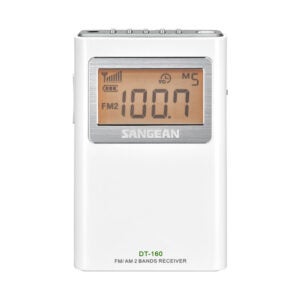
If you’re looking for a superior pocket radio, check out the DT-160 from Sangean. This slim, lightweight radio uses two AA batteries, and it will run for around 100 hours (at average listening volume). It features a Dynamic Bass Boost button to help improve the audio quality as well. The large, easy-to-read LCD screen features a built-in clock and signal-strength indicator. It works well with the digital tuner, allowing you to dial in your favorite station to its exact frequency. This Sangean model enables you to set 10 FM stations and five AM stations, so you don’t have to fumble around with the tuner. There is no built-in speaker to make this pocket radio heavy or larger than absolutely necessary; simply plug in your headphones and hit a preset station, and you can kick back and enjoy.
Best Bang for the Buck
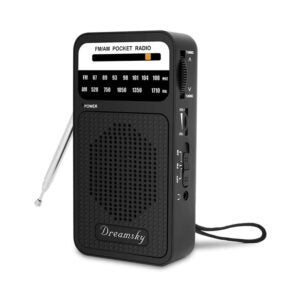
If you’re looking for a high-quality pocket radio with a low price tag, the DreamSky Pocket Radio is a great choice. This dual-band radio features analog tuning to access FM or AM stations and stay up-to-date with important news or weather broadcasts. It has a built-in speaker as well as a built-in headphone jack if you’d prefer to keep your music to yourself. The included wrist strap is great for clipping onto a backpack. The DreamSky uses two replaceable AA batteries for simplicity and has a 16.5-inch antenna to help you get the best possible reception in a variety of situations.
Best Shortwave
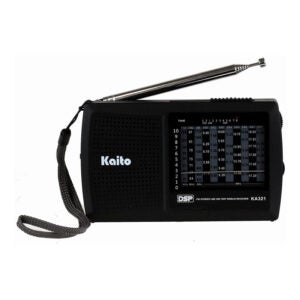
The Kaito KA321 Pocket-Size Radio allows fans of shortwave radio to continue their long-range listening wherever they are. The KA321 has 10 bands, as well as AM radio and an FM range from 64 to 108 MHz. The built-in speaker is loud, with a volume-adjustment knob on the side. It has a built-in headphone jack, as well as a jack for an electrical adapter, though you’ll have to buy that separately (available here). When it comes to shortwave bands, the Kaito KA321 offers eight, covering frequencies between 5.7 and 21.95 MHz. It also has a built-in telescoping antenna to make the most of your FM and shortwave listening potential. This top shortwave pick features analog controls and a dedicated tuning knob for easy and fast frequency tuning.
Best Longwave
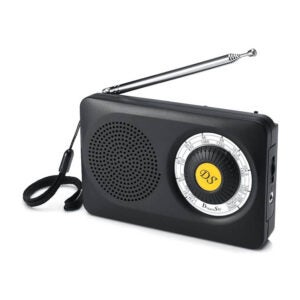
If you’re looking for a high-quality radio with do-all reception, DreamSky’s portable radio should be on your radar. This compact pocket radio is less than an inch thick but has plenty of power for picking up longwave AM broadcasts, as well as a telescoping antenna for your FM-listening delight. This radio runs on two AA batteries and features a 3.5-millimeter headphone jack, as well as a powerful built-in speaker. The simple design makes it easy for anyone to use, including technology-averse seniors. The low price is budget-friendly, making it an excellent choice for emergency preparedness; keep one in your car, another in an emergency backpack, and one at home to stay alert to important information. With an easy-to-operate analog display dial, you can search your favorite stations easily and quickly.
Best Bluetooth
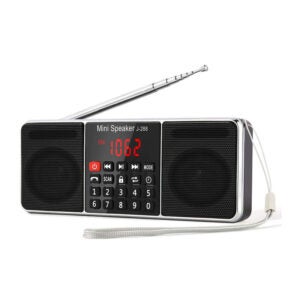
Finding a pocket radio that doubles as a Bluetooth speaker isn’t necessarily easy; finding a high-quality model is even harder. The J-288 from PRUNUS is an excellent choice, providing a digital tuner that’s easy to dial in, as well as Bluetooth-speaker capability, allowing you to stream your favorite station from your phone. The upgraded 4.0 Bluetooth technology dramatically enhances the transmission speed, re-connects to the paired device automatically, and can also be used as a hands-free telephone receiver. (Bluetooth headphones are not supported.) It has AM/FM radio capability and a sleep timer to shut off the radio after you fall asleep. The J-288 has an extra-long FM antenna to boost its reception and provide the clearest possible audio. It also has a rechargeable onboard battery, meaning you don’t have to keep spare batteries around to listen to your favorite tunes. Finally, the PRUNUS J-288 features an easy-to-read LCD digital display.
Best Waterproof
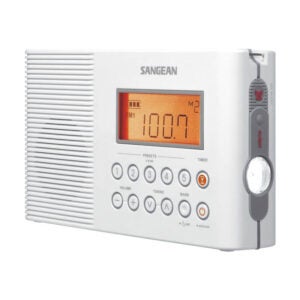
Sangean designed the H201 specifically for water applications. This shower radio works well in your bathroom, but it doubles nicely as a reliable, weatherproof option for the trail or boat. It has 20 presets: 10 for FM, five for AM, and five for weather-related stations. The digital display has a handy backlight, helping you see the tuner in low-light conditions. It also has a flashlight built into the side and a swivel handle for convenient carrying, as well as an emergency buzzer to help draw attention if you find yourself in a dangerous scenario. This radio is a little heavy, however, requiring two D batteries for wire-free operation.
Best for Weather Updates
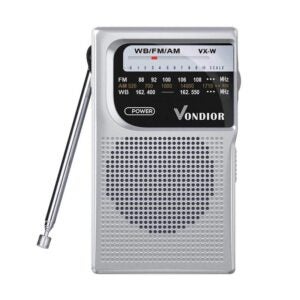
If you’re putting together an emergency-preparedness kit, you know that space is an important factor. Big, heavy radios will take up room needed for other essential items. Vondior’s NOAA Weather Radio is compact and light, allowing you to throw it in any kit. It uses two AA batteries, an analog tuning system, and a built-in antenna to pick up FM stations. It also picks up continual weather updates and important emergency weather alerts from the NOAA. For more relaxed scenarios, the Vondior can play your favorite FM station or AM talk show through its loud built-in speaker, or you can keep your jams to yourself by plugging your headphones into the built-in mono headphone jack.
The Advantages of Owning the Best Pocket Radio
- Pocket radios can keep you up-to-date on dangerous weather conditions. These portable radios are an integral part of a comprehensive emergency plan. These small battery-powered radios can help you stay up-to-date during dangerous storms, even when the power goes out. If you spend a lot of time camping or hiking in remote areas, having a pocket radio helps you remain aware of changing weather conditions and important news.
- You’ll have some portable entertainment anywhere you need it. Some entertainment can help pass the time in many scenarios. Whether you’re on a long train ride, in a doctor’s waiting room, or at a family function (when you’d rather not be), you can tune into a music station or game, throw on some headphones, and block out the world for a bit.
- Pocket radios can be the gateway to a new hobby. Some radio-listening hobbyists enjoy seeing how far out of range they can travel and still receive clear broadcasts. There’s an entire community of radio enthusiasts, some of whom prefer to tune in with small pocket radios. You may find that your pocket radio becomes a gateway to a new and entertaining hobby.
Tips for Using a Pocket Radio
- Increase your elevation to boost your reception. If you’re hiking or camping, and you’re not finding the level of radio reception you need, you can try moving to higher ground. Radio waves travel at the line of sight, so you may need to raise your elevation (or attach an external antenna when applicable) to get the best reception.
- Keep batteries on hand for emergencies. If your pocket radio’s primary use is receiving emergency weather broadcasts, waiting until the storm is upon you to check your batteries is a recipe for failure. Keep fresh batteries on hand, and if possible, match your radio batteries with your flashlight’s to ensure that you always have a stash of the right ones.
- Use an external speaker to increase your audio quality. The best way to increase the audio quality of your pocket radio is to use an external speaker. While it won’t reduce the static, it will improve the built-in speaker’s sound quality. You’ll need to plug the external speaker into your headphone jack and be sure to keep it charged (or keep batteries on-hand), but the improved audio quality will help you squeeze more entertainment out of a tiny radio.
FAQs About Your New Pocket Radio
You may still have some questions about these pocket radios, and that’s understandable. They’re something of a forgotten technology, and as with any knowledge, if you don’t use it, you lose it. Here are some of the most frequently asked questions and answers about pocket radios.
Q. What is the difference between digital and analog tuning?
Digital tuning uses an LCD screen to show your current frequency, while analog tuners use a display range with a moving needle (or a stationary needle with a moving range) to confirm your position. Digital tuners are far more exact, but analog tuners allow you to scan the entire range faster.
Q. Do pocket radios sound good?
“Good” is a relative term. As better-quality speakers have become smaller and more affordable, the quality of pocket radio speakers has increased. However, a pocket radio probably won’t sound as good as your desktop speakers or your car’s audio system.
Q. How do you troubleshoot poor radio reception?
FM radio transmissions are tuned using the built-in, telescoping whip antennas, while AM radios use internal antennas. Reposition the FM antenna while turning the dial to improve your reception. AM stations are far more challenging to troubleshoot, and if there’s a weak AM signal in your area, there’s very little you can do.
tinyurlis.gdv.gdv.htu.nuclck.ruulvis.netshrtco.detny.im
مقالات مشابه
- شرکت صادرات و واردات کالاهای مختلف از جمله کاشی و سرامیک و ارائه دهنده خدمات ترانزیت و بارگیری دریایی و ریلی و ترخیص کالا برای کشورهای مختلف از جمله روسیه و کشورهای حوزه cis و سایر نقاط جهان - بازرگانی علی قانعی
- گوشی اپل لیست قیمت + آفرهای ویژه خرید آیفون امروز 23 آذر
- ارتش DC نگهبان پس از بررسی هلیکوپتر نظامی وزوز معترضان در DC
- چرا همه مرده اند در مورد حلقه شنا بادی اشتباه می کنند و چرا باید این گزارش را بخوانید
- شرکت صادرات و واردات کالاهای مختلف از جمله کاشی و سرامیک و ارائه دهنده خدمات ترانزیت و بارگیری دریایی و ریلی و ترخیص کالا برای کشورهای مختلف از جمله روسیه و کشورهای حوزه cis و سایر نقاط جهان - بازرگانی علی قانعی
- The Best Rain Jackets for Outdoor Work and Adventure
- کربن فعال تصفیه
- 5 راه حل برای قالب در پنهان کردن خود را در ماشین لباسشویی
- شرکت صادرات و واردات کالاهای مختلف از جمله کاشی و سرامیک و ارائه دهنده خدمات ترانزیت و بارگیری دریایی و ریلی و ترخیص کالا برای کشورهای مختلف از جمله روسیه و کشورهای حوزه cis و سایر نقاط جهان - بازرگانی علی قانعی
- چگونه داروهای گیاهی خود را در در آینده بهبود دادم